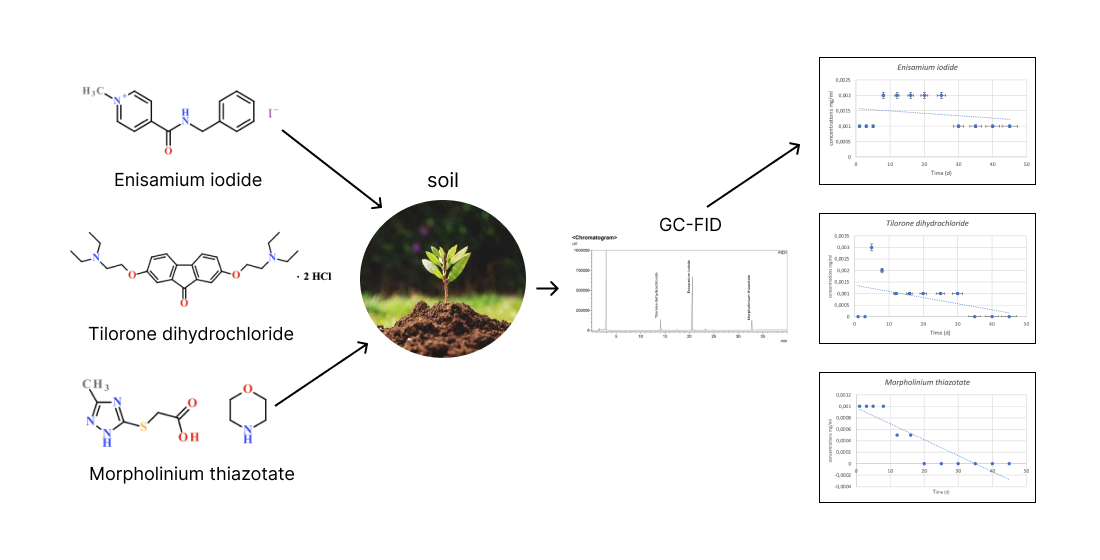Вивчення поведінки деградації енісаміуму йодиду, тілорону дигідрохлориду, морфолінію тіазотату у грунті методом ГХ-ПІД
DOI:
https://doi.org/10.15587/2519-4852.2024.300209Ключові слова:
ГХ-ПІД, навколишнє середовище, грунт, енісаміум йодид, тілорону дигідрохлорид, морфолінію тіазотатАнотація
Мета. Вивчити поведінку енісаміуму йодиду, тілорону дигідрохлориду, морфолінію тіазотату та придатність раніше розробленої методики ГХ-ПІД у грунті.
Матеріали і методи. Визначення енісаміуму йодіду, тілорону дигідрохлориду та морфолінію тіазотату у ґрунті за допомогою газової хроматографії з полум'яно-іонізаційним детектором за допомогою колонки Rxi-5 ms (довжина 30 м, зовнішній діаметр 0,25 мм, товщина рідкої стаціонарної фази 0,25 мкм).
Результати. Проведено вивчення поведінки у грунті енісаміуму йодиду, тілорону дигідрохлориду, морфолінію тіазотату та визначення придатності розробленої методики ГХ-ПІД для визначення у грунті. Досліджено час напіврозпаду у грунті, який склав для енісаміуму йодиду 45 днів, тілорону дигідрохлориду 30 днів, морфолінію тіазотату 7 днів та константа швидкості розпаду відповідно 0,001 мг/мл, 0,001 мг/мл та 0,0005 мг/мл.
Висновки. Раніше розроблена нами методика ГХ-ПІД є придатною для визначення енісаміуму йодиду, тілорону дигідрохлориду, морфолінію тіазотату у грунті, пидібрані необхідні умови аналізу. В аеробних умовах швидкість розсіювання вибраних фармацевтичних препаратів слідувала наступному порядку зменшення енісаміум йодиду > тілорону дигідрохлорид > морфолінію тіазотат у ґрунті
Посилання
- Makowska, M. H., Spychała, M., Gajewska, K. (2024). Impact of Pharmaceuticals on the Individual Wastewater Treatment System. Journal of Ecological Engineering, 25 (2), 257–266. https://doi.org/10.12911/22998993/176945
- Fisher, J. (2022). Pharmaceuticals in rivers threaten world health – study (2022). BBC News. Available at: https://www.bbc.com/news/science-environment-60380298
- Wilkinson, J. L., Boxall, A. B. A. (2022). Pharmaceutical pollution of the world's rivers. Proceedings of the National Academy of Sciences, 119 (8). https://doi.org/10.1073/pnas.2113947119
- Küster, A., Adler, N. (2014). Pharmaceuticals in the environment: scientific evidence of risks and its regulation. Philosophical Transactions of the Royal Society B: Biological Sciences, 369 (1656), 20130587. https://doi.org/10.1098/rstb.2013.0587
- Du, J., Fan, Y., Qian, X. (2014). Occurrence and behavior of pharmaceuticals in sewage treatment plants in eastern China. Frontiers of Environmental Science & Engineering, 9 (4), 725–730. https://doi.org/10.1007/s11783-014-0661-1
- Du, J., Fan, Y., Qian, X. (2014). Occurrence and behavior of pharmaceuticals in sewage treatment plants in eastern China. Frontiers of Environmental Science & Engineering, 9 (4), 725–730. https://doi.org/10.1007/s11783-014-0661-1
- Gbadegesin, L. A., Tang, X., Liu, C., Cheng, J. (2022). Transport of Veterinary Antibiotics in Farmland Soil: Effects of Dissolved Organic Matter. International Journal of Environmental Research and Public Health, 19 (3), 1702. https://doi.org/10.3390/ijerph19031702
- Method 542 is a liquid chromatography, electrospray ionization, tandem mass spectrometry (LC/ESI-MS/MS) method for the determination of pharmaceuticals and personal care products (PPCP) in finished drinking water. 815-R-15-012 (2016). Available at: https://www.epa.gov/dwanalyticalmethods/method-542-determination-pharmaceuticals-and-personal-care-products-drinking
- European Union strategic approach to pharmaceuticals in the environment (2019). European Commission. Available at: https://oeil.secure.europarl.europa.eu/oeil/popups/ficheprocedure.do?lang=en&reference=2019/2816(RSP)
- Zhou, L., Martin, S., Cheng, W., Lassabatere, L., Boily, J.-F., Hanna, K. (2019). Water Flow Variability Affects Adsorption and Oxidation of Ciprofloxacin onto Hematite. Environmental Science & Technology, 53 (17), 10102–10109. https://doi.org/10.1021/acs.est.9b03214
- Eggen, T., Vogelsang, C. (2015). Occurrence and Fate of Pharmaceuticals and Personal Care Products in Wastewater. Comprehensive Analytical Chemistry, 245–294. https://doi.org/10.1016/b978-0-444-63299-9.00007-7
- Waste from health-care activities: A global review and assessment of management practices (2018). Geneva: World Health Organization.
- Zhang, Z., Rhind, S. M., Kerr, C., Osprey, M., Kyle, C. E. (2011). Selective pressurized liquid extraction of estrogenic compounds in soil and analysis by gas chromatography–mass spectrometry. Analytica Chimica Acta, 685 (1), 29–35. https://doi.org/10.1016/j.aca.2010.11.013
- Massé, D., Saady, N., Gilbert, Y. (2014). Potential of Biological Processes to Eliminate Antibiotics in Livestock Manure: An Overview. Animals, 4 (2), 146–163. https://doi.org/10.3390/ani4020146
- Yang, X., He, X., Lin, H., Lin, X., Mo, J., Chen, C. et al. (2021). Occurrence and distribution of natural and synthetic progestins, androgens, and estrogens in soils from agricultural production areas in China. Science of The Total Environment, 751, 141766. https://doi.org/10.1016/j.scitotenv.2020.141766
- Belikova, A., Materienko, A., Sidorenko, L., Chorna, O., Burdulis, D., Georgiyants, V. (2022). Development of a method for the detection of amixin and amizon by HPLC on SunFire C18 column. Chemija, 33 (3), 79–86. https://doi.org/10.6001/chemija.v33i3.4750
- Kruglov, O., Panasenko, Je., Zalavs’kyj, Ju., Lebed’, V., Afanas’iev, Ju., Nazarok, P. (2019). Magnetic receptivity of chernozem soils of Kharkiv area and its diagnostic significance. Visnyk Agrarnoi Nauky, 97 (10), 12–17. https://doi.org/10.31073/agrovisnyk201910-02
- Francisco de Oliveira, G., Rabechini Jr, R. (2019). Stakeholder management influence on trust in a project: A quantitative study. International Journal of Project Management, 37 (1), 131–144. https://doi.org/10.1016/j.ijproman.2018.11.001
- Belikova, A., Ivanauskas, L., Sidorenko, L., Chorny, V., Kononenko, A., Koval, A., Georgiyants, V. (2023). Greening of the method for simultaneous determining the enisamium iodide and tilorone dihydrochloride using GC-FID assay. ScienceRise: Pharmaceutical Science, 6 (46), 47–52. https://doi.org/10.15587/2519-4852.2023.295120
- RSEI Model Version 2.1 Technical Appendix B (2014). Available at: https://www.epa.gov/sites/default/files/2014-03/documents/tech_app_b_v21.pdf
- Belikova, A., Materienko, A., Sidorenko, L., Chornyi, V., Korzh, I., Kucherenko, L. et al. (2022). Development of a method for determining the morpholinium thiazotate using more economic and green GC/MS assay with an fid detector. ScienceRise: Pharmaceutical Science, 3 (37), 4–11. https://doi.org/10.15587/2519-4852.2022.259879

##submission.downloads##
Опубліковано
Як цитувати
Номер
Розділ
Ліцензія
Авторське право (c) 2024 Anastasiia Belikova, Liudas Ivanauskas, Lyudmila Sidorenko, Oleksandr Honcharov, Olha Holovchenko, Zoia Kovalenko, Victoriya Georgiyants

Ця робота ліцензується відповідно до Creative Commons Attribution 4.0 International License.
Наше видання використовує положення про авторські права Creative Commons CC BY для журналів відкритого доступу.








